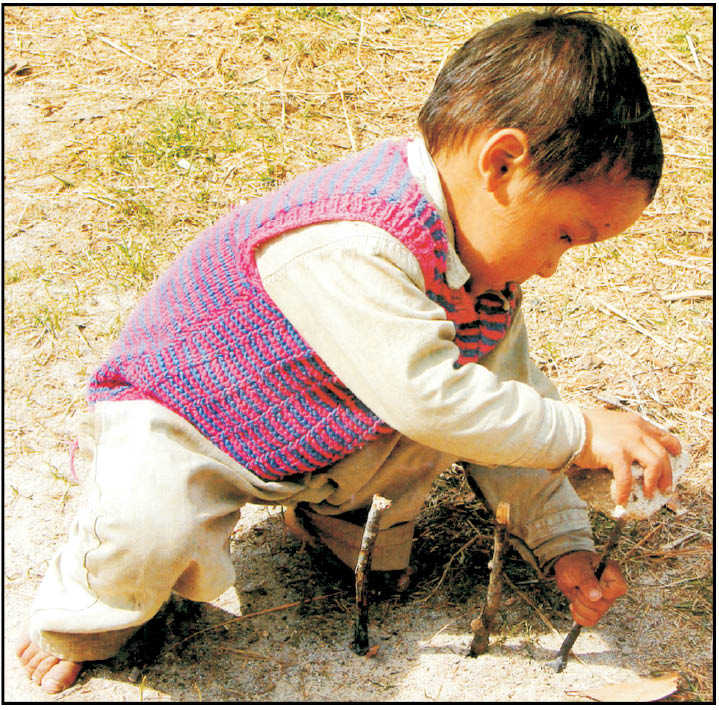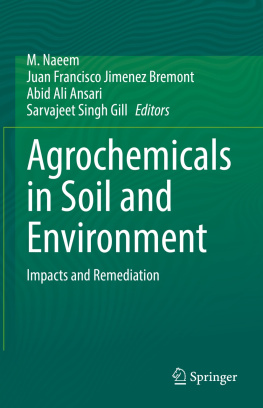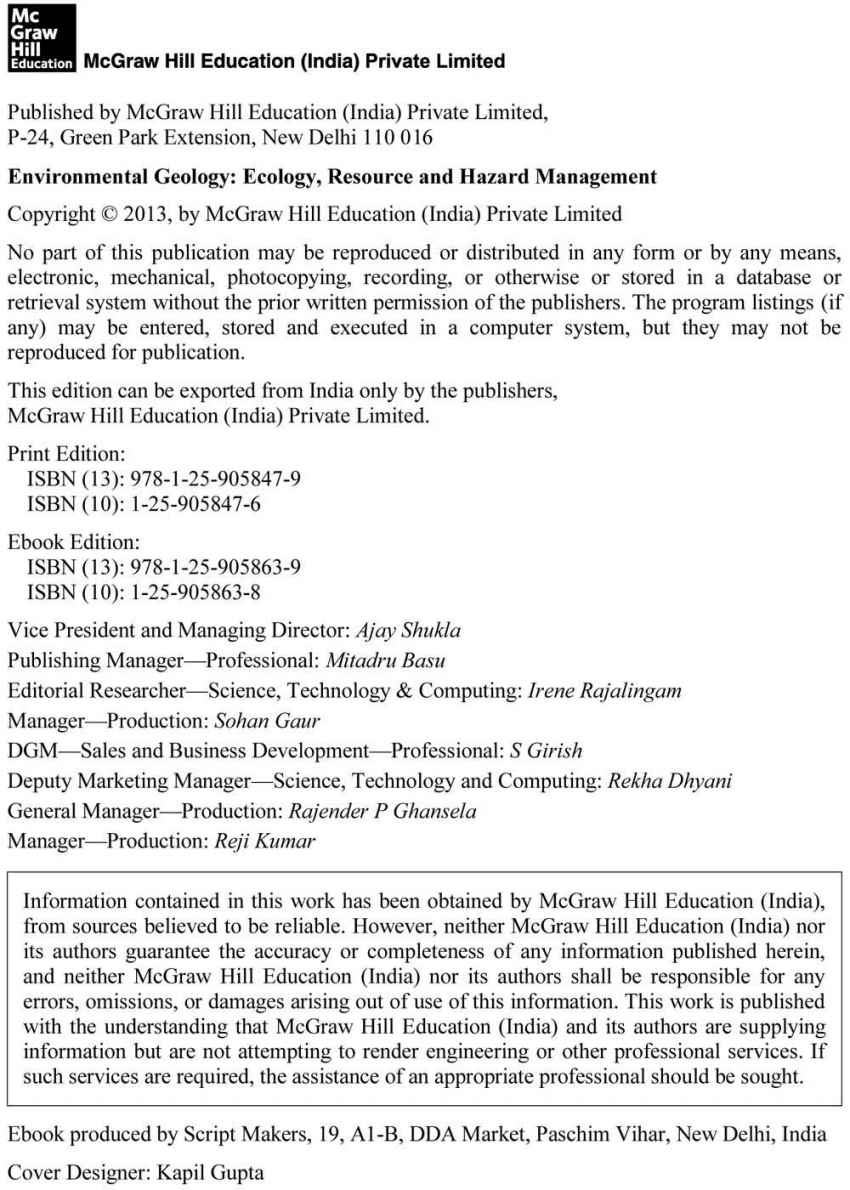
To The
People Of Tomorrow
Whose Future
We Are Selling
To
Finance Our Present
Mourn not the dead
But rather mourn the apathetic throng
The cowed and meek
Who see the worlds great anguish and its wrong
And dare not speak
Ralph Chaplin
| Preface to the Second Edition |

I wrote the book Environmental Geology: Indian Context at a time of the Indian history when the persons at the helm of affairs of the Government of India, and the academics and researchers all over India were imbued with engaging and energizing spirit of friendship for nature. The scientists were coming out with revealing and seminal works on the health and well-being of the environment of the Indian landmass.
Times have changed changed radically in the last two decades. The waves of globalization have swept the world. The attendant storms of liberalization have overwhelmed the decision makers and the powerful sectors of the society. Our nation seems to be in the stranglehold of the insatiable urge to become rich at any cost, unmindful of the health and safety of the natural environment. The consequence is that in order to finance its present, this generation is selling the future of the generations to come. This is true everywhere in the world, more so in India.
Compared to the earths biological capacity of 15.7 hectares per person, the peoples environmental demand is more than 21.9 hectares per person, implying that we are living far beyond what nature offers us. Frightening is the rate of the consumption of resources, which is faster than the galloping rate of growth of the population, nearly half of which is hungry.
Since the systems of honest monitoring, guidance, supervision or inspection at every level of governance have collapsed, there is no way to check or contain the reckless overuse as well as misuse of the precious and finite resources the nature has offered us land, soils, forests, water and minerals.
Those who enjoy money power and who are able to manipulate the system of the governance (borrowing the words of Justice G.S. Singhvi and Justice A.K. Ganguli, The Hindu , February 2, 2012) rule the roost in India. Under such a situation as this, while the corporate world and unscrupulous elements of the society are being offered natural assets at the throw-away costs, the people at large are deprived of the common property resources and therefore have turned indifferent to their natural surrounding and resources. The consequence is there to see there are no compassionate stakeholders and no genuine custodians of the natural environment of India. So, everything is going wrong the protective cover of natural forests is diminishing, the rate of loss of land is increasing, the springs are drying up and discharges of rivers dwindling, the groundwater table is going down, the rivers are getting increasingly poisoned, and the air is becoming progressively unbreathable. Today the common man feels that his life is becoming more and more difficult, whatever the Gross Domestic Product data indicate.
I cannot help feeling that I am part of the system that failed to redeem the pledge to strive for preserving the health of Indias environment. I must confess my guilt for not having done enough.
When I first wrote this book thirty years ago, I had hoped that in the revised edition I will portray a beautiful India, a healthy India. Alas, I am presenting a more dismal, more disheartening picture.
I recall what a celebrated lawyer of India once said we are the people who turn our heads and pretend that we do not see anything going wrong, and we shamelessly pretend not to have heard people cry.
The stark reality is that we do not mind the wilting or even death of the dreams of the generation that would replace us tomorrow.
I cannot help reciting the proverb of the Cree tribe of the Red Indians in North America
Only after the last tree has fallen
Only after the last river has been poisoned
Only after the last fish has been caught
Only then will be realized that money cannot be eaten.
However, looking at the eyes of the youths and the children of India, I feel hopeful that the people of tomorrow will sooner or later bring Indias environment back to its health.
K.S. Valdiya
Jawaharlal Nehru Centre for Advanced Scientific Research
Bangalore 560 064
| Preface to the First Edition |

This book is addressed primarily to students both at the undergraduate and postgraduate levels, and is written with the objective of creating an awareness for preserving the natural environment, conserving the earths resources, coping with geological hazards, and participating in technological and industrial development without disturbing the ecological balance. However, it will also be of interest to the general public including engineers, architects, teachers and planners. The book makes an attempt to weave the diverse components of the ecology into the fabric of geology, bringing out the interlinkages and interdependence between various environmental factors. It highlights the various environmental stresses the land in India is being subjected to and the resultant deterioration in the quality of life, elucidating not only the natural and anthropogenic causes of the degradation of land and its soil carpet, but also the implications of resource depletion. The strategies used for the scientific management of land, soil, water and mineral resources are discussed, as also measures to prevent their destruction, degradation and misuse, and the means by which the damaged parts of the landscape and the earths resources can be restored are suggested.
The book dwells on the occurrence of natural hazards resulting from quickened earth processes and suggests ways and means of coping with them, including mitigating or abating the risks.
Focusing attention on the interaction between man and earth, and elucidating the impact of irrational developmental activities on the stability and survival of the web of ecosystems, the section on engineering geology and geotechnics offers a strategy and methodology of development without destruction of the environment and harm to the resource base.
Explaining the causes, sources and dimensions of pollution and waste production, alternative options for energy generation without threat to the landscape, atmosphere and water bodies are suggested.
The book was written during my tenure as a Pitambar Pant National Environment Fellow in 1982-84. I am deeply grateful to the Department of Environment, Government of India, for the fellowship and the very generous assistance that came with it. To Ramesh Upadhyay, Kewalanand Lohni, Sukesh Bartariya, Dungar Singh Negi and Vishwanath Ghoshal I owe a debt of gratitude for the help rendered.














